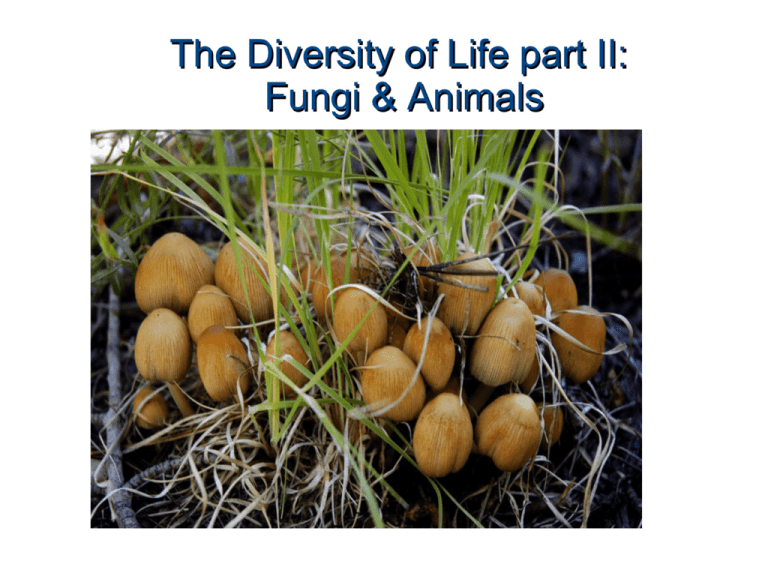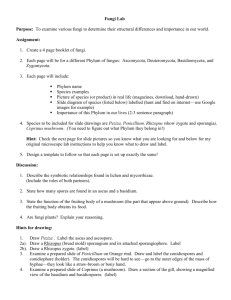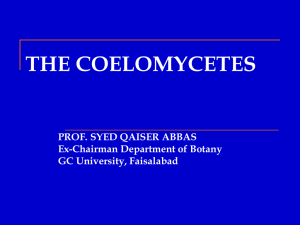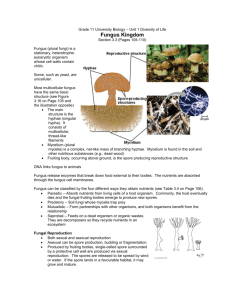Chapter 10: Classification and life cycles:
advertisement

The Diversity of Life part II: Fungi & Animals Fungi (Ch 16, p. 328) Note: Fungal classification & phylogenetic relationships described here are based on: D. S. Hibbett et al. 2007, A higher-level phylogenetic classification of the Fungi. Mycological Research 111: 509-547. Importance of Fungi (p. 330) Important decomposers (along with heterotrphic bacteria), recycle materials. Some are serious pests & pathogens. Yeasts: baking, brewing, & winemaking. Important symbiotic associations: Mycorrhizae. Lichens Characteristics of Fungi (p. 329) Heterotrophic absorbers, grow on/in. Feeding strategies: Saprophytes. Parasites & pathogens. Symbionts. Majority are multicellular. 100,000 species described likely many more exist! Growth form usually filamentous: Fungal filaments= Hyphae Mass of hyphae=Mycelium Cell walls composed of Chitin. Fungal Reproduction (p. 329) Propogate by releasing numerous haploid spores: Asexual Asexual spores = conidia. Also fragmentation of hyphae. Sexual Zygote usually only truly diploid stage. Immediately undergoes meiosis, forms spores. Unique sexual cycle: Meiosis, Gamete formation, & 2phase fertilization: plasmogamy, then Karyogamy. Generalized Fungal lifecycle Zygote (2N) Karyogamy Growth of reproductive structures Meiosis Dikaryotic hyphae (1n+1n) spores Plasmogamy Gamete formation Hyphae of opposite mating strains contact Mitosis Fungal hyphae (1n) Main Groups of Fungi Evolved from common ancestor with animals. Chytrids Other fungal Glomeromycetes Ascomycetes Basidiomycetes (Arbuscular groups (Sac fungi) (Club fungi) mycorhhizae) Chytrids Mostly aquatic & wetsoil fungi. Spores have flegella. Glomeromycetes (AMF) Also know as arbuscular mycorhhizal fungi (AMF) One of the main groups of mycorrizal fungi (p. 322). AMF form symbiotic relationships with > 80% of all plant species. Fungus enhances root absorption. Plant feeds fungus Categorized as endomycorrizae: penetrate into plant tissues. AMF make for a healthy, happy plant! AMF in root tissue Ascomycetes Largest group of fungi. Named for their reproductive sacs or asci. Asci organized into large visible structures (mushrooms) in some species. Life cycle includes extensive dikaryotic phase Morel Ascus: The Micrscopic Reproductive “Sac” of Ascomycetes Ascus Basidiomycetes Named after diagnostic microscopic club-shaped reproductive organ: Basidium. Include many familiar mushrooms, toadstools, puffballs, etc. Several plant diseases (rusts & smuts). Many are forest ectomycorrhizae. Extensive dikaryotic phase Basidium Mushrooms: Basidium-producing reproductive organs Rust fungus on leaf Other Fungi Four 'subphyla' not currently classified into phyla because phylogenetic relationships still not clear. Mainly portions of a polyphyletic group formerly known as 'zygomycetes' Phylum Microsporidia Earliest-diverging fungal evolutionary branch. Small, highly specialized animal parasites. Microsporidia Zygomycete' mold on dead leaves Yeasts General term for Unicelluar fungi: Most are ascomycetes. Saccharomyces sp. Commercial yeast of brewing, winemaking, & baking (p. 331). Yeast cells A beer, brewed using yeast Lichens (p. 332) Symbiotic partnerships between fungus & a green alga or cyanobacterium. “Trade off”: carbohydrates (fungus) for a safe environment (Alga). The fungus-partner is usually an Ascomycete Many can survive in in harsh environments: Arctic, rocks, etc. Mycorrhizae: Symbiotic Association Between Plant Roots & Fungi (p. 332) Found in 90% plant species! Enhance plant nutrient & water absorption Fungus fed by plant. 2 main types: Arbuscular mycorrhizae : Phylum Glomeromycota Penetrate into roots (endomycorrhizae) Most widespread type, >80% of plants. Ectomycorrhizae: Surround roots but don’t penetrate. Locally: pines, oaks & other forest trees. Most are Basidiomycetes, many familiar forest mushrooms. Pine seedling with ectomycorrhizae Animals (Ch. 17) First Animals: PreCambrian period (1200-670 M.Y.A.) More than 2 million species. Roughly 35 phyla 0nly part of 1 phylum & 50,000 are vertebrates. Characteristics of Animals (p. 338-340): Multicelled. Heterotrophs. Feed by ingestion (eating). Aerobic respiration. Sexual reproduction. Motile (move around) for at least part of life. Complex sequence of embryonic development. 3 tissue systems form in most groups: Ectoderm, Endoderm & Mesoderm (p. 340). Diversity in Animal Body Plans (p.340) Symmetry: Radial Bilateral Gut types: Saclike (one opening) Tubular (2 openings) Body Cavities Presence of a body cavity (=Coelom) lined with mesoderm-derived peritoneum: (most bilateral lineages). No coelom: Flatworms & a few other invertebrates. Animal Phylogeny (P. 340): Evolutionary relationships among the 9 main animal phyla. See Fig. 17.5, p. 340. Sponges (Phylum Porifera) p. 341 Asymetrical Minimal differentiation of cells and tissues: Flattened surface cells line cavities & outer surface. Amoeboid cells between the 2 linings. No organs. Protein fibers & glass-like structures of silica & calcium carbonate stiffen the body. Sponges (Phylum Porifera) p. 340 Feeding: Cilia cause water to flow through pores & chambers. Surface cells capture water-borne bacteria & food particles. Reproduction: Sperm released into water Fertilized eggs develop into microscopic, free swimming larvae**. Larvae disperse, settle, and begin to grow. **Larva (Pl. Larvae): Immature form of a species. sponge larvae Cnidarians (Phylum Cnidaria): Jellyfish & Anemones, etc (p. 342). Radial-symmetric with tentacles. Tentacles of some species with poisonous sting. Simple tissues each with different cell types. Saclike (anus=mouth) gut. Two body forms: Medusa–free floating, bell-shaped with tentacles. Medusae Polyp–attached, tube-like, ring of tentacles at unattached (mouth) end. Contractile cells enable movement. Medusae move by contracting bells & emitting a water jet. Exmples of Cnidarian Diversity Colonial cnidarians: Portuguese man-of-war: medusa & series of tentacled polyps. Sea anemone (polyp body form) Corals Colonies of polyps connected by calcium-rich external skeletons (the reef). Symbiotic algae supplement feeding. Man-of-war Sea anemone Corals Flatworms (Phylum platyhelminthes) p. 344 Bilatteral symmetry Saclike gut, highly branched for increased nutrient absorption. Tapeworms: Mamalian gut parasitesT 3 Classes of Flatworms: Turbellarians: Free-living aquatic worms Flukes: Microsopic parasites Tapeworm Diet? Yuck!!! Can you believe this??? Diet add from the 1800's Schistomsomiasis: (p. 344) A tropical disease from a parasitic fluke (flatworm) Alternates between humans and snails Infection by exposure to infested waters Weakness & lethargy Liver, spleen, bladder & kidney damage Serious problem in some tropical countrys. Annelids (Phylum Annelida) Segmented Worms (p. 345) Bilateral body, segmented into many repeating, similar units. Well developed internal organs-(partially repeat in each segment). Rudimentary brain (organ to integrate nerve sensory input) at head. Complete (tubular) gut (digestive tract). 16,000 or more species. Include earthworms, leeches, & marine polychaete worms. Segments Leach Earthworm Polychaete Molluscs (Phylum Mollusca) Bilateral symmetry. Small coelom & fleshy, soft body; complete gut. Mantle: skirt-like tissue that drapes over body. Mantle secrets a shell of calcium carbonate & proteins. Gills for gas exchange. Well-developed internal organs Nearly 100,000 species. (p. 343) Mollusc Diversity: Gastropods Largest Class: Snails & slugs, etc. Mollusc Diversity: Bivalves Clams, Oysters, etc. Shell in 2 parts (valves) Mollusc Diversity: Cephalopods Squid & octopus Reduced/ absent shell Streamlined & fast Large brain, complex behavior Jet propulsion Roundworms (Phylum Nematoda) Bilateral worms. (P. 346). Complete (tubular) gut: both mouth and anus. Numerous & widespread Many soil-dwelling species Most free-living: important detritivores/ nutrient recyclers in ecosystems. Some nematodes are serious plant parasites. Human/ mammal parasites: Hookworms, Trichinella, Elephantiasis, dog heartworm. Nematodes parasitic nematodes killing Insect: for sale on gardening website! Phylum Arthropoda: Arthropods (p. 347-352) Largest, most widespread animal group > 1,000,000 species “most successful organisms on earth” 5 groups: Trilobites, Arachnids, insects, centipedes/ millipedes, & Crustaceans. Fossil Trilobite Arthropod Adaptations Hardened exoskeletons: Chitin. Support body & provide resistance for muscle contractions. Molting (shedding of old, too-small exoskeleton during growth). Jointed appendages (can move at joints despite rigid exoskeleton. Fused and modified body segments. Respiratory structures (branching tubes deliver oxygen directly to cells). Division of labor: Juvenile (larval) stages growth & development, adults: dispersal & reproduction. Arachnids: Spiders & their kin (p. 348) Spiders Ticks & mites Horseshoe crabs Scorpions Crustaceans (p. 349) pillbugs Crawfish (yummy!!) Crabs & shrimp Lobster(also yummy) Centipedes & Millipedes (p 350) Insects (p. 350-352) More than 800,000 species! Largest arthropod (and animal) group! Butterfly Fly Cockroach Cricket Moth Beetle Echinoderms (Phylum Echinodermata) (p. 353) Radial symmetry with some bilateral features (bilateral ancestry). Endoskeletоn (internal skeleton). Decentralized nervous system (no brain). Often have defensive spines. Related to chordates (that's us!). Starfish Sea Urchin Brittle star Chordates (Phylum Chordata) p. 355 Bilateral symmetry 4 Basic features develop in all chordate embryos: (p. 383) Supporting rod for body (notochord). Dorsal nerve cord. Pharyngeal slits: grooves in pharynx (throat) Post-anal tail. Some of these features may be modified /disappear as adults develop. All but Tunicates, Lancelets & hagfishes are Vertebrates (see p. 355). Lancelet Vertebrates (p. 355-360) Most of the Chordates Dorsal nerve cord enclosed in a “backbone” of either cartilage or bone. Brain enclosed in protective cartilaginous or boney chamber (= Cranium). Vertebrate classes: Jawless fishes (lampreys) Cartilaginous fishes Boney fishes, Amphibians Reptiles (includng birds & dinosaurs) Mammals. Vertebrate Diversity: fishes (P. 356) Jawless fishes: Lampreys Cartilaginous fishes: sharks & Rays Vertebrate Diversity: Boney Fishes P. 355 Vertebrate Diversity: Amphibians P. 357. Vertebrate Diversity: Reptiles (p. 258) “Traditional” Reptiles: Paraphyletic group: Only part of a lineage that also includes birds & dinosaurs. Some modern classifications (our book) have expanded reptiles to include birds. Vertebrate Diversity: Birds -the Surviving Dinosaurs (p. 359) Vertebrate Diversity: Mammals P. 360 Mammary (milk) glands & hair The End! Version 13.04






